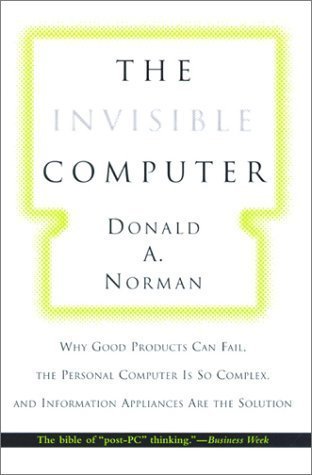
| Title | : | The Invisible Computer: Why Good Products Can Fail, the Personal Computer Is So Complex, and Information Appliances Are the Solution |
| Author | : | |
| Rating | : | |
| ISBN | : | 0262640414 |
| ISBN-10 | : | 9780262640411 |
| Format Type | : | Paperback |
| Number of Pages | : | 320 |
| Publication | : | First published January 1, 1998 |
Technologies have a life cycle, says Donald Norman, and companies and their products must change as they pass from youth to maturity. Alas, the computer industry thinks it is still in its rebellious teenage years, exulting in technical complexity. Customers want change. They are ready for products that offer convenience, ease of use, and pleasure. The technology should be invisible, hidden from sight.
In this book, Norman shows why the computer is so difficult to use and why this complexity is fundamental to its nature. The only answer, says Norman, is to start over again, to develop information appliances that fit people's needs and lives. To do this companies must change the way they develop products. They need to start with an understanding of people: user needs first, technology last--the opposite of how things are done now.
The Invisible Computer: Why Good Products Can Fail, the Personal Computer Is So Complex, and Information Appliances Are the Solution Reviews
-

This book, written by the same author as "The Design of Everyday Things", is a really interesting look at computers, software and human-centered design in the late 1990's.
The book is sub-titled "Why good products can fail, the personal computer is so complex, and information applicances are the solution.". This is a nice summary of the entire book.
Norman begins by looking at previous inventions, including the phonograph, and the initial versions failed despite the fact that this versions were technologically superior to later successful incarnations. This happened because they failed to take into account the basic requirements of the user.
He then looks at the current state of PC's and considers this in terms of a technology maturity, where a critical mass of users has now built up, such that to increase the user base, the next wave of users will need to be those who are not technologically proficient. These users have different demands for the technology, most specifically that they expect to buy applications to carry out tasks rather than the technology itself.
Norman argues that because the PC has been designed to attempt to do everything for all users, it is fundamentally too complex to suit this next wave of users. He proposes a new type of device which will address the needs of these users - the "Information Appliance". Examples of these already exist in applications such as car computers and calculators.
He points out that for wide-spread adoption/success of such devices, a cruicial last step will be for a standard for communications and information exchange between the devices will be required.
He concludes the book by documenting the changes needed in organisations to carry out the Human Centered Design process that will be needed for such devices to emerge, and then provides details of what some of these devices may be like.
It will be interesting to see how Norman's predictions pan out in the long term. -

----quote---
And guess what the most effective protest method is? Incisting on following procedures.
If you have to add a sign that says push or pull, then this indicates that the door is not as simple as is possible; its design is faulty. -

If you've read other works by Donald Norman, some parts of this book will already be familiar to you; the new stuff starts in chapter 9. Either way, this was an interesting read, especially his predictions of the future made ~20 years ago.
-

A great book for any designer of ANYTHING, but due to its age and the speed with which technology advances, this book is filled with outdated references and examples. If the examples were updated to modern tech, this book would be even better!
-

One of first books about importance of UX (called UE here). Some forecast became true, many of scifi devices mentiond are now apps inside smartphones.
-

See
my review, originally published in Design magazine, 1999 -

This is a great addition to The Design of Everyday Things as this one (obviously) talks about computers much more.
Interestingly, the iPhone, iPad, Androids, Kindle, Nook, and other specific technologies seem to be proving him right (at least in a general way). -

I always enjoy Norman's books. Have to say it's been awhile since I've read one or seen a new one. Just found TIC when unpacking.
-

Beau geste!!!
-

out of date, not much useful info. ( other than ' affordments ' )
-

A must read!
